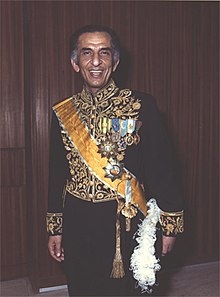Jamshid Amouzegar
Jamshid Amouzegar | |
|---|---|
 | |
| 71st Prime Minister of Iran | |
| In office 7 August 1977 – 27 August 1978 | |
| Monarch | Mohammad Reza Shah Pahlavi |
| Deputy | Gholam Reza Azhari |
| Preceded by | Amir-Abbas Hoveida |
| Succeeded by | Jafar Sharif-Emami |
| Minister of Interior | |
| In office 1 March 1974 – 7 August 1977 | |
| Prime Minister | Amir-Abbas Hoveida |
| Preceded by | Kamal Hassani |
| Succeeded by | Gholam Reza Azhari |
| Minister of Finance | |
| In office 1 February 1965 – 1 March 1974 | |
| Prime Minister | Amir-Abbas Hoveida |
| Preceded by | Amir-Abbas Hoveida |
| Succeeded by | Hushang Ansary |
| Leader of Rastakhiz Party | |
| In office 1 August 1974 – 27 August 1977 | |
| Deputy | Javad Saeed |
| Preceded by | Amir-Abbas Hoveida |
| Succeeded by | Javad Saeed |
| Personal details | |
| Born | 25 June 1923 Tehran, Iran |
| Political party | Nationalist Party (1960-1975) Rastakhiz (1975-1977) |
| Spouse | Ulriche Amouzegar (1925-2005) |
| Alma mater | Cornell University |
| Signature |  |
Jamshid Amouzegar (born 25 June 1923) is an Iranian economist, artist and politician who was Prime Minister of Iran from 7 August 1977 to 27 August 1978 when he resigned. Prior to that, he was Minister of Interior and Minister of Finance in the cabinet of Amir-Abbas Hoveida. He was the leader of Rastakhiz Party during his tenure as prime minister.
Early life
Born on 25 June 1923 in Tehran, Iran, he first climbed his way to college graduating with degrees in Law and Engineering from Tehran University. While World War II was brewing, he was able to enroll in Cornell University. After completing his PhD at Cornell University, he returned to Iran and became deputy minister in Iran's ministry of Health, under Dr Jahanshah Saleh in 1955. Amouzegar was among the first of Iran's politicians schooled and trained in the United States. Prior to that time, Iran's elite were almost entirely trained in France, among other European countries.
Political career
Amouzegar first took the post of Minister of Labor and then Minister of Health in the cabinet of prime minister Hasan-ali Mansour. He subsequently became Minister of Finance in the cabinet of Amir Abbas Hoveida after the assassination of Prime minister Mansour in 1964, remaining in that post for nine years. From 1965 to 1974 he headed several ordinary meetings of the OPEC.[1] In 1971, he and Sheikh Ahmed Zaki Yamani of Saudi Arabia were instrumental in implementing the series of price hikes that ultimately quadrupled the price of oil and provided the resources for Iran to modernize its infrastructure, agriculture, and defense. For this accomplishment, Amouzegar was awarded the Taj-e Iran, first class, an honor normally reserved for only the prime minister and former prime ministers. He was appointed Minister of the Interior in 1974.
On 21 December 1975, he was taken hostage by the Venezuelan terrorist Carlos the Jackal during an OPEC meeting. Carlos was ordered to execute him, but did not do so, and Amouzegar was released along with the other hostages after a few days.
In 1977, he became chairman of the Rastakhiz (Resurrection) party, having led the Progressive faction against Finance Minister Hushang Ansary's Liberal Constructionist faction. Soon after Jimmy Carter became president of the United States, Amouzegar was appointed prime minister of Iran in August 1977[2] in Ramsar, succeeding his rival Amir Abbas Hoveyda. However, he rapidly became unpopular as he attempted to slow the overheated economy with measures that, although generally thought necessary, triggered a downturn in employment and private sector profits that would later compound the government's problems. Hence, in the wake of Khomeini's revolution, he soon resigned and was replaced by Jafar Sharif-Emami.
Jamshid Amouzegar currently resides in the United States.
-
Amouzegar elected as prime minister of Iran on 7 August 1977
-
Amouzegar, Jafar Sharif-Emami Chairman of Senate, Abdollah Riazi Chairman of Parliament, Hassan Emami Famous lawyer and Imam of Tehran Friday prayer services, Celebrate 100th birthday of Reza Shah
Quotes
We Iranians were invaded by Greeks, Arabs, Mongols, and Turks, but we never lost our identity because foreign invaders would find a richer culture in Persians than that of their own.
References
- ^ "162th Ordinary Meeting" (PDF). OPEC. Retrieved 17 February 2013.
- ^ Ali Gheissari (2006). Democracy in Iran (PDF). New York City: OUP. Retrieved 20 February 2013.
{{cite book}}: Unknown parameter|coauthors=ignored (|author=suggested) (help)
Source used for this article
- 'Alí Rizā Awsatí (عليرضا اوسطى), Iran in the Past Three Centuries (Irān dar Se Qarn-e Goz̲ashteh - ايران در سه قرن گذشته), Volume 2 (Paktāb Publishing - انتشارات پاکتاب, Tehran, Iran, 2003). ISBN 964-93406-5-3.
- Qajar (Kadjar) Orders and Decorations


